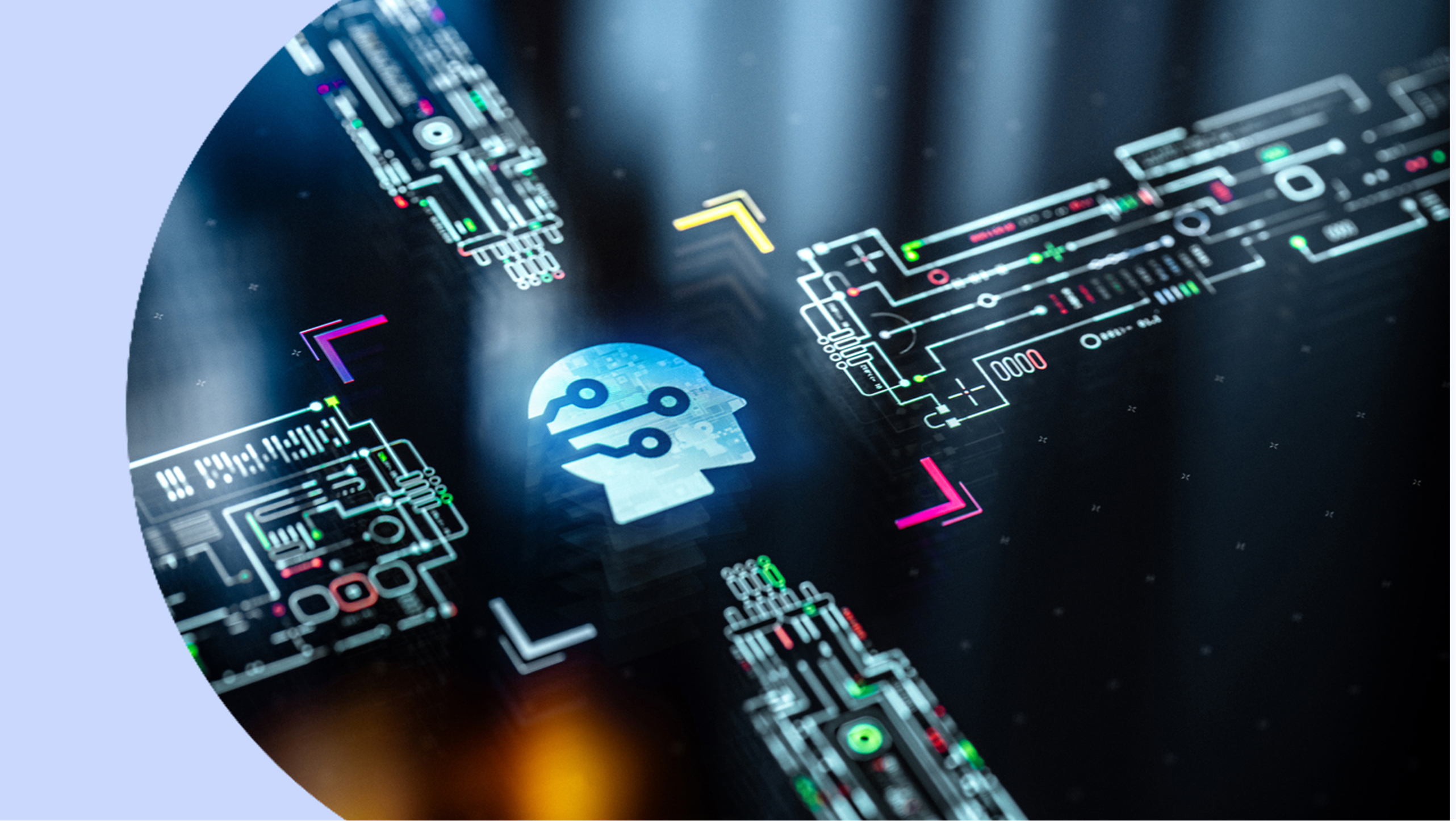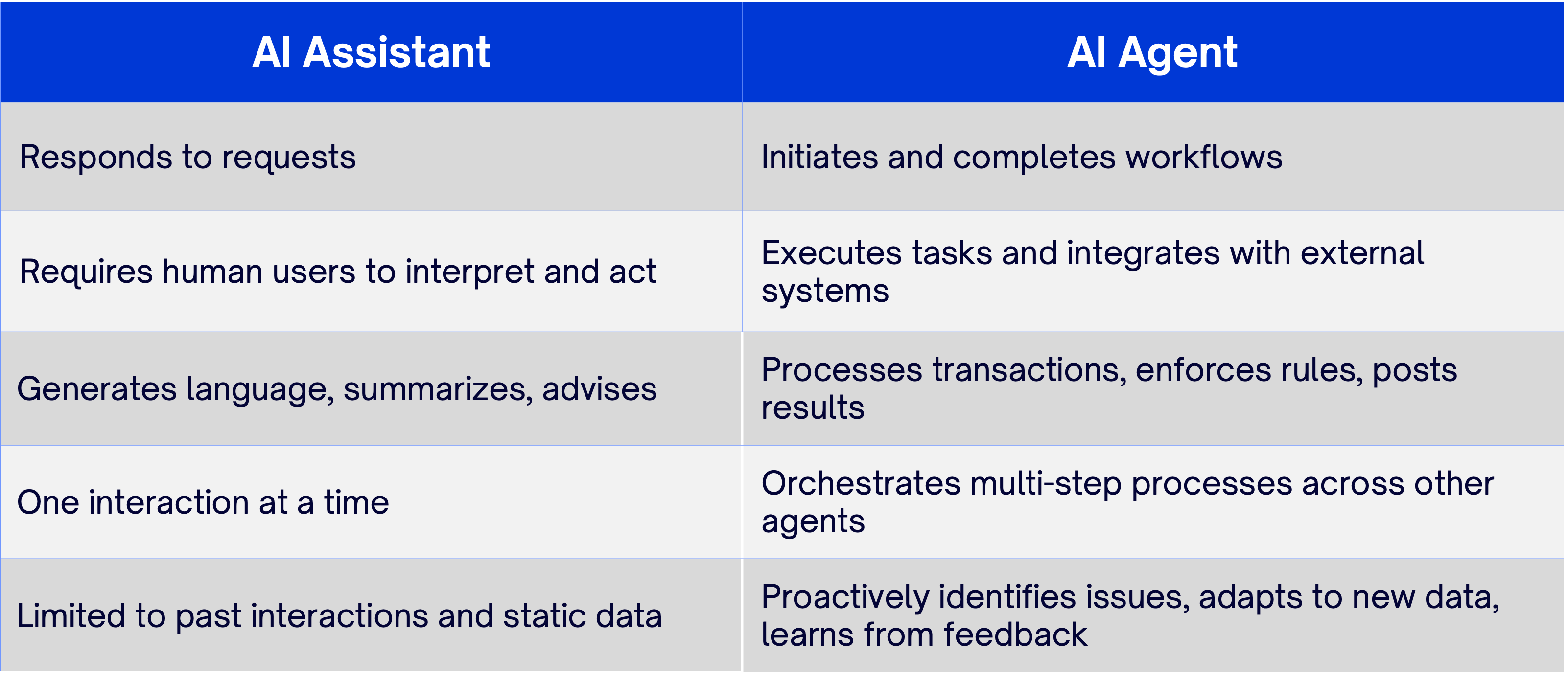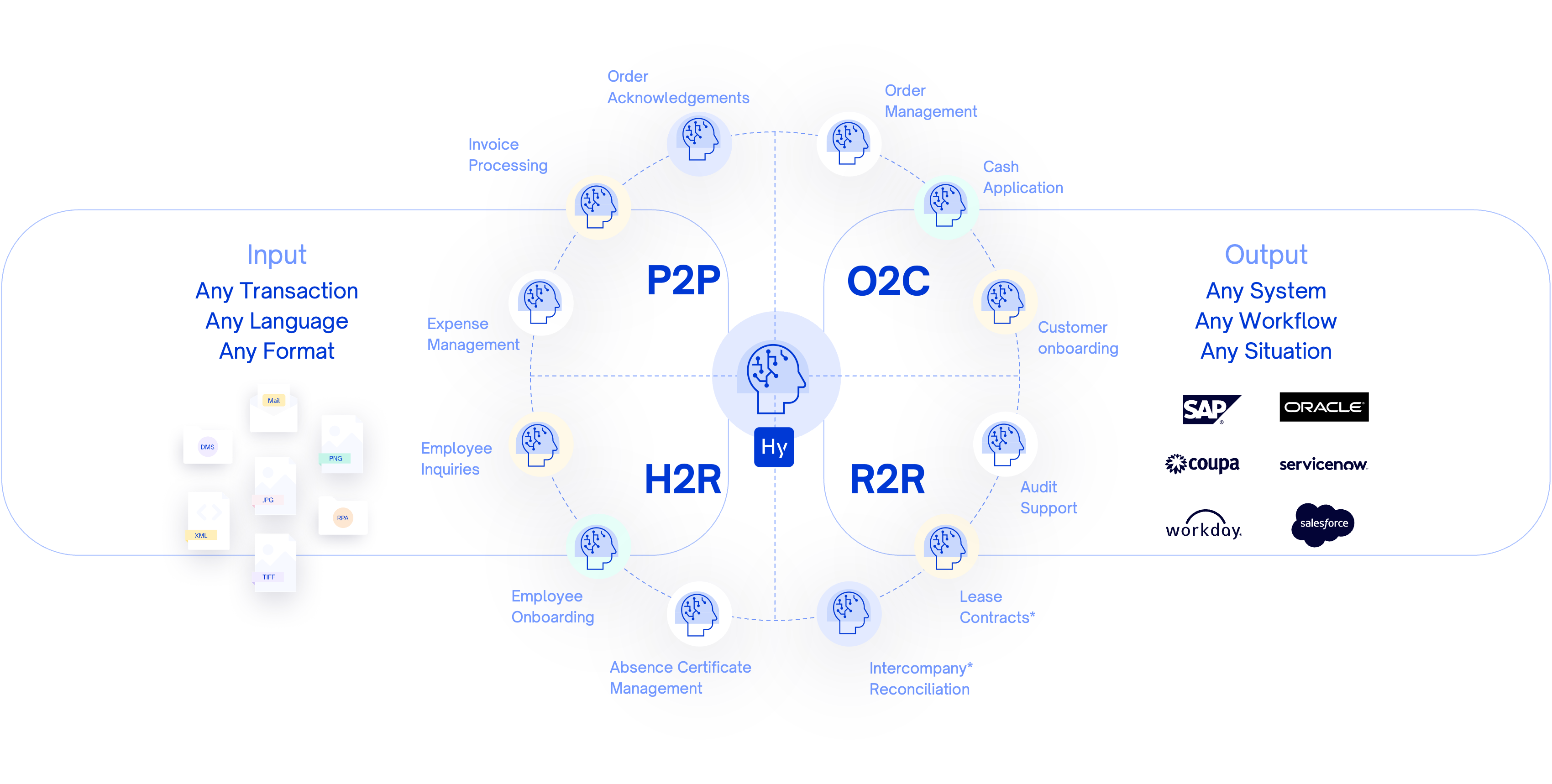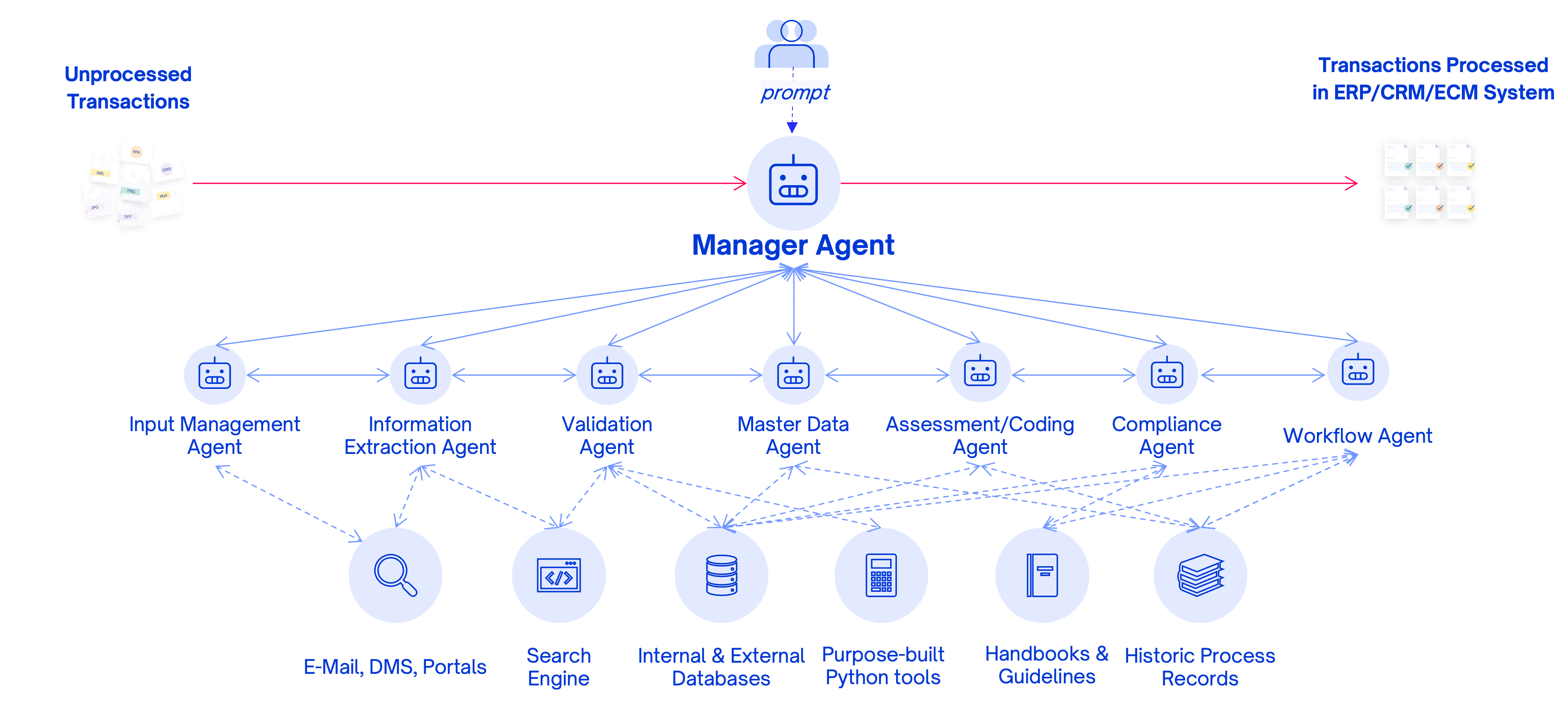Discover why AI agents and AI assistants might sound similar, but they're as different as day and night.

Every CFO has been pitched an "AI solution" in the past six months. What keeps them from signing is not the demo, it is the question that comes after: Will this actually reduce my headcount needs, or am I just adding another tool my team has to manage?
The difference between AI agents and AI assistants is not semantic, but operational. One answers questions, the other closes the books. One waits for instructions; the other identifies patterns in your invoice data, flags exceptions, and posts journal entries on its own.
If your organization is still treating AI as a chatbot for finance queries, you are solving the wrong problem.
The real value is not in generating language or delivering detailed responses to user requests. It is in automating complex workflows end to end, with minimal human intervention and maximum audit readiness.
Here is how to tell the difference, and why it matters for your next procurement decision.
AI assistants are reactive systems built to respond to human users.
Think Google Assistant, ChatGPT, or any tool that waits for a prompt and generates an answer. They rely on natural language processing and large language models to understand human language, retrieve past data, and provide informed decisions based on user requests.
AI assistants excel at:
But they stop there. An AI assistant will not execute tasks on its own. Or it will not connect to your customer management systems, validate an invoice against a purchase order, and route it for approval.
It waits for you to ask, then waits for you to act.
On the other hand, AI agents are autonomous systems that perform tasks without waiting for instructions. AI agents use machine learning techniques and feedback mechanisms to adapt, learn, and improve over time.
There are several agent types, each designed for different environments:
The most advanced systems today are multi-agent systems, where multiple AI agents collaborate to tackle complex tasks across business processes. One agent might extract data from a PDF. Another validates it against your ERP. A third routes exceptions to human supervisors. Each agent handles discrete steps, and together they automate complex workflows that used to require human supervision at every stage.
This is where agentic process automation (APA) separates from task automation. Agents do not just automate routine tasks. They complete tasks that span systems, require judgment, and adapt to dynamic environments.
Still confused? Here's the cheat sheet:


Most vendors will tell you they have "AI-powered" automation. What they mean is they have better OCR. They can read a document faster. But reading is not processing. And processing is not agentic.
Hypatos delivers Agentic Process Automation (APA). Not smarter document capture or another layer of RPA duct tape. End-to-end workflows that run autonomously, adapt to exceptions, and improve without retraining models or opening service tickets.
Here is what that looks like in practice:
Traditional solutions measure success in "documents scanned per hour." Hypatos measures straight-through processing rates. One global fashion retailer achieved 80% STP in 6 months, cutting invoice cycle time from 4 weeks to 5 days and reducing manual effort by 40% across 800,000 annual invoices.
Unlike simple reflex agents or utility-based agents locked into predefined rules, Hypatos agents are learning agents. They adapt based on feedback mechanisms, past data, and real-world outcomes.
When a new document type appears, or a supplier changes formats, the agent adjusts without requiring your IT team to rewrite scripts or retrain machine learning models.
Most enterprise AI projects take 18 months and fail before go-live. Hypatos goes from contract to production in 4 weeks, with ROI in 6 months. Why? Because building AI agents the Hypatos way means deploying pre-built, pre-trained agents for common business processes, not starting from scratch.
Hypatos ships with production-ready agents for:
Each agent handles repetitive tasks that used to require human agents to review every line. Now your team intervenes only on true exceptions.
Integrating AI agents into legacy systems is where most pilots die. Hypatos connects natively to SAP, Workday, Coupa, xSuite, and other external systems. No middleware. No custom development. Agents read from and write to your ERP using open APIs and the Model Context Protocol (MCP), so they communicate with your data without vendor lock-in.
Every action taken by a Hypatos agent is logged with full traceability: the prompt, the input data, the reasoning, and the outcome. Auditors can trace a journal entry back to the original invoice, the PO, the validation logic, and the agent that executed it. One system. One audit trail. No parallel controls.
This is not generative AI pretending to understand your process. This is agent technology purpose-built for regulated environments where explainability and security posture are not optional.
The line is clearer than vendors make it sound.
Examples: Writing a board memo, summarizing customer feedback,generating code snippets for software development.
Examples: Processing invoices from receipt to payment, reconciling bank statements, routing expenses for approval, etc.
The threshold question
Ask yourself: If this process ran perfectly tonight while I slept, would I trust the result in the morning?
If yes, you need an agent. If no, you probably need an assistant, or you need to define the process more clearly before automating it.

For complex workflows, the answer is not one agent.
It is multiple AI agents working together. One agent extracts invoice data, another cross-checks it with your purchase order system. A third applies tax rules, a fourth posts the transaction, a fifth monitors duplicate payments.
Each agent is a specialist. Together they automate routine tasks faster and more reliably than any monolithic system. And because they communicate through lightweight protocols, not through a vendor's orchestration layer, you can swap, upgrade, or retire individual agents without redeploying the entire stack.
Adopting agents is not about buying software. It is about redesigning how work flows through finance. Here is how to start without betting the farm.
Step 1: map your repetitive tasks
Agents shine on work that repeats. Start with processes that:
Top candidates in finance: invoice processing, expense management, bank reconciliation, vendor onboarding, intercompany settlements.
Step 2: identify where humans add Value (and where they don’t)
Humans are terrible at repetitive tasks. We get tired, skip steps and make errors on line 487 of a 500-line report.
Agents automate repetitive tasks flawlessly. But they should escalate complex tasks that require judgment, emotional intelligence, or stakeholder negotiation. Your goal is not to eliminate people. It is to let people do the work only people can do.
Step 3: start with one process, one agent
Do not try to automate your entire close process in month one.
Pick one workflow. Deploy one agent. Measure STP rate, error reduction, and cycle time. Prove ROI an then expand.
Step 4: build a feedback loop
The best agents are learning agents. They improve when you tell them what went wrong. Set up feedback mechanisms so your team can flag errors, approve edge cases, and refine logic. Unlike traditional AI models that require retraining, modern agentic systems let you adjust behavior by editing prompts or updating rules in plain language.
Step 5: integrate, do not rip and replace
You do not need to replace your ERP to adopt agents.
Agents sit on top of your existing systems. They read data, apply intelligence, and write results back. Hypatos connects to SAP, Workday, Coupa, and other platforms via APIs, so you get the benefit of intelligent automation without a migration project.
Step 6: measure what matters
Track these metrics:
These are not projections. These are live results from production deployments. If your vendor cannot show you comparable numbers from real customers, you are not buying an agent. You are buying a pitch.
Step 7: plan for scale
Once one agent proves ROI, the next ten come faster. The same invoice agent that runs in your German entity can run in France, the UK, and the US with localized tax rules and language support. This is the power of agent technology: agents are reusable, composable, and portable.
APA completes the process, not just a step in the process. One agent handles extraction, validation, routing, posting, and exception management while your team does other work.
If your team is reconciling invoices manually, chasing approvals at month-end, or spending 40% of their time on data entry, you don't need more planning. You need to deploy one agent, prove the ROI, and move on to the next process.
Want to see what that looks like for your operation? Get in touch and we'll walk you through it.
Further stories from our blog

